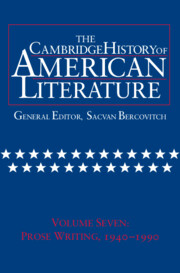Book contents
- Frontmatter
- Introduction
- The Drama, 1940—1990
- Fiction and Society, 1940–1970
- After the Southern Renascence
- Postmodern Fictions, 1960–1990
- 1 Rethinking Postmodernism
- 2 Fables of the Fetish
- 3 The End of Traditionalism
- 4 Women’s Fiction: The Rewriting of History
- 5 Conclusion
- Emergent Literatures
- Appendix: Biographies
- Chronology, 1940–1990
- Bibliography
- Index
4 - Women’s Fiction: The Rewriting of History
from Postmodern Fictions, 1960–1990
Published online by Cambridge University Press: 28 March 2008
- Frontmatter
- Introduction
- The Drama, 1940—1990
- Fiction and Society, 1940–1970
- After the Southern Renascence
- Postmodern Fictions, 1960–1990
- 1 Rethinking Postmodernism
- 2 Fables of the Fetish
- 3 The End of Traditionalism
- 4 Women’s Fiction: The Rewriting of History
- 5 Conclusion
- Emergent Literatures
- Appendix: Biographies
- Chronology, 1940–1990
- Bibliography
- Index
Summary
In the 1970s and 1980s, the modernist division between avant-garde and traditional fiction was coming to an end. As relativism, indeterminacy, self-reflexiveness, and absurdity became generally recognizable as a description of contemporary experience, experimentalism shifted from a goal in itself to a vehicle for a redefined realism.
The normalizing of the experimentalist ethos — so important in novels by men — was equally crucial for women writers. Beginning in about 1970, an unprecedented explosion of novels by and about women appeared in print, a simple fact in itself, but one that represented a fundamental change in the meaning of women’s experience. By writing, by being published, by finding an audience receptive to their work, women de facto redefined their status in our culture. They achieved a “voice” where before they were voiceless; they wrote themselves into history — both political and literary — when previously they had been strikingly absent from it. Women writers found immediately relevant the postmodern tenet that history is a construct serving an ideology and open to varying interpretation. The problem was how to appropriate the authority to tell stories of the past, and how to structure them in such a way as to generate a different kind of future.
- Type
- Chapter
- Information
- The Cambridge History of American Literature , pp. 499 - 527Publisher: Cambridge University PressPrint publication year: 1999



